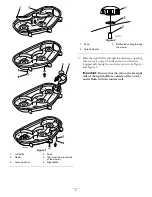
Operation
Converting to Side-discharge
Operation
Without the grass deflector, discharge cover,
or complete grass catcher assembly mounted
in place, you and others are exposed to blade
contact and thrown debris. Contact with
rotating mower blade(s) and thrown debris will
cause injury or death.
•
Never remove the grass deflector from
the mower because the grass deflector
routes material down toward the turf. If the
grass deflector is ever damaged, replace it
immediately.
•
Never put your hands or feet under the
mower.
•
Never try to clear the discharge area or
mower blades unless you move the blade
control switch (PTO) to disengage and turn
the ignition key to off. Also remove the key
and pull the wire off the spark plug(s).
Note:
To use the mower in side discharge mode, only
the right baffle must be removed. Mounting hardware
must be installed in open holes.
1. Stop the engine and remove the ignition key.
2. Remove the 2 knobs and curved washers that secure
the right baffle to the mower.
3. Remove the right baffle and lower the grass
deflector over the discharge opening.
Important:
Ensure the mower has a hinged
grass deflector that disperses clippings to the
side and down toward the turf, while in side
discharge mode.
4. Install the fasteners you removed previously into
the holes in the top of the mower to prevent flying
debris.
To mulch grass clippings, install the right baffle, refer to
Installing the Baffles.
Operating Tips
Selecting the Proper Height-of-Cut
Setting to Suit the Conditions
Remove approximately one inch or no more that 1/3
of the grass blade when cutting. In exceptionally lush
and dense grass you may have to raise the height-of-cut
setting another notch or convert to side discharge or
bagging operations.
Mowing in Extreme Conditions
Air is required to cut and recut grass clippings in the
mower housing, so do not set the height-of-cut too low
or totally surround the housing by uncut grass. Always
have one side of the mower housing free from uncut
grass, allowing air to be drawn into housing. When
making an initial cut through the center of the uncut
area, operate the machine at a slower speed and back
up if the mower starts to clog.
Mowing at the Proper Intervals
Under normal conditions you’ll need to mow every
4-5 days. However, grass grows at different rates at
different times. Thus, in order to maintain the same
height-of-cut, which is a good practice, you’ll need to
cut more frequently in early spring; as the grass growth
rate slows in mid summer, cut only every 8-10 days.
If you are unable to mow for an extended period due
to the weather conditions or other reasons, convert to
side discharge or bagging options or mow first with the
height-of-cut at a high level; then mow again 2-3 days
later with a lower height setting.
Always Mow with Sharp Blades
A sharp blade cuts cleanly and without tearing or
shredding the grass blade like a dull blade. Tearing and
shredding causes the grass to turn brown at the edges
which impairs growth and increases susceptibility to
disease.
Cleaning After Operating
To ensure optimum performance, clean the underside
of the mower housing. If residue is allowed to build up
in mower housing, cutting performance will decrease.
4






















